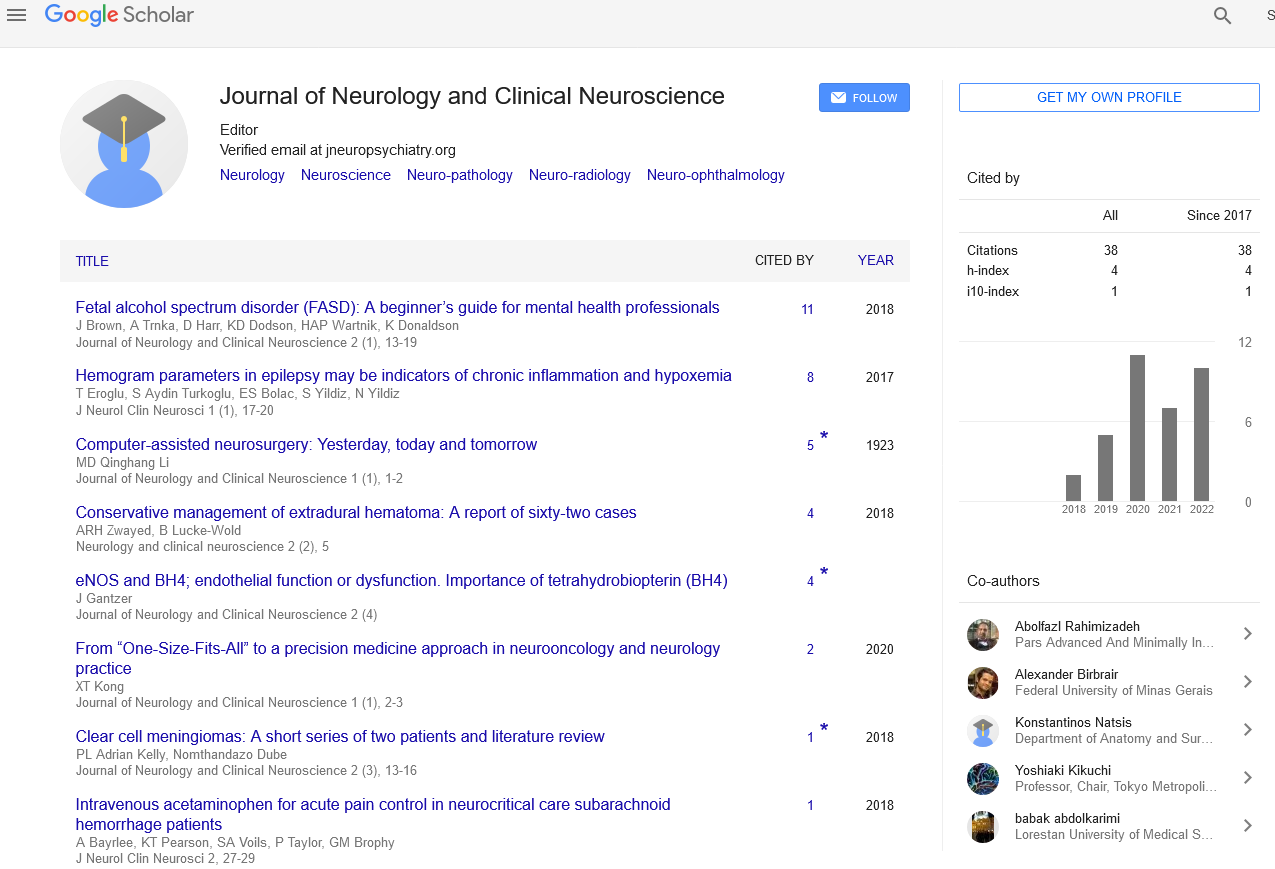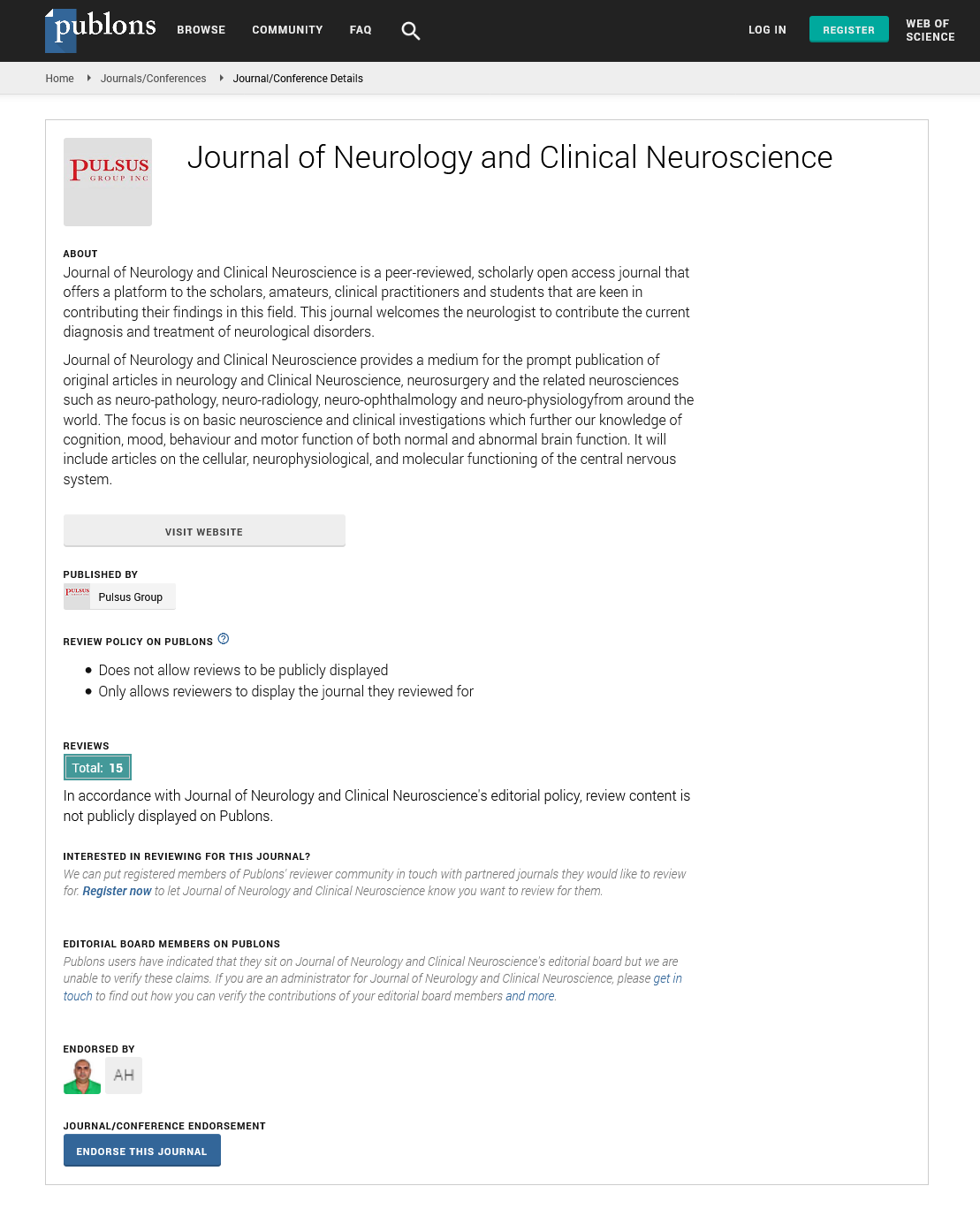Endothelium, endothelial progenitor cells and stroke
Received: 02-Apr-2018 Accepted Date: Apr 03, 2018; Published: 09-Apr-2018
Citation: Bayraktutan U. Endothelium, endothelial progenitor cells and stroke. J Neurol Clin Neurosci. 2018;2(2):02-03.
This open-access article is distributed under the terms of the Creative Commons Attribution Non-Commercial License (CC BY-NC) (http://creativecommons.org/licenses/by-nc/4.0/), which permits reuse, distribution and reproduction of the article, provided that the original work is properly cited and the reuse is restricted to noncommercial purposes. For commercial reuse, contact reprints@pulsus.com
Editorial
Stroke continues to be one of the leading causes of mortality and morbidity in the western world. It is usually classified into two main categories, haemorrhagic and ischaemic which in turn are further classified into various subtypes due to location of the haemorrhage; subarachnoid space (SAH) and intracerebral space (ICH) or the cause of cerebral blood flow interruption i.e. small vessel disease, large-artery atherosclerosis and cardioembolic strokes.
Despite constituting about 15% of all strokes in the Western populations, haemorrhagic strokes account for much of the stroke-related mortality and morbidity. There is currently no pharmacological treatment for haemorrhagic strokes and early surgery may only slightly improve survival rates without significantly affecting disability at 6 months [1]. Ischaemic strokes, on the other hand, constitute about 85% of all stroke cases. Despite being the most common cause of human brain damage, the modulation of the coagulation cascade by recombinant tissue plasminogen activator (rt-PA) remains as the only approved pharmacotherapy for this debilitating condition. However, due to short therapeutic window after a cerebral ischaemic attack (4.5 h of stroke onset), only 3-5% of patients at the present time receive this therapy. Brain oedema resulting from ischaemic injury represents the main cause of death within the first week after an ischaemic stroke and is characterised, at molecular level, by disruption of the tight junctions that normally prevent the leakage of blood constituents to brain parenchyma through interendothelial cell openings [2,3].
Intriguingly, over the years a large number of therapeutic agents have demonstrated efficacy under in vitro conditions or in animal models of ischaemic or haemorrhagic stroke. However, the subsequent clinical trials conducted using the same agents failed to replicate these favourable results. Hence, it is important to analyse the causes of the past failures and have stringent standards in place to develop clinically relevant diagnostic or prognostic biomarkers and novel therapeutics for stroke or its specific (sub) types. One of the main drawbacks regarding translational stroke research is that the overwhelming majority of the agents used in the above mentioned clinical trials have focused on specific pathways pertaining to either recanalisation of vessels or excitotoxicity to reduce neuronal death, while many other processes are involved spatially and temporally in the pathophysiology of stroke. Given that stroke patients go on to manifest different levels of incapacity or no clinical signs at all, it is reasonable to think that endogenous systems are involved in the mitigation of ischaemic and haemorrhagic brain injury through their effects on neurons, glia, blood vessels or combinations of all three.
Although various risk factors, notably hypertension, diabetes mellitus and hyperlipidaemia are implicated in cerebrovascular structural and functional changes preceding a stroke, in most cases endothelial dysfunction appears to represent the main pathology that triggers or exacerbates the majority of the vascular abnormalities. The endothelium covers the entire inner surface of all blood vessels and modulates vascular homeostasis through intricate regulation of a series of distinct functions such as vascular tone, permeability, thrombosis, angiogenesis and inflammation [4,5]. Hence, it is of paramount importance to preserve endothelial integrity and function at all times to prevent development of strokes and to manage response to treatments after stroke. Once induced, endothelial dysfunction renders cerebral vasculature susceptible to atherosclerosis and subsequent vascular events such as enhanced plaque vulnerability and thrombus formation. It also causes and worsens hypertension through successive inductions of arteriosclerosis and peripheral vascular resistance [5,6]. Interestingly, even in cases where endothelial dysfunction may not be regarded as the primary insult, like ICH secondary to coagulopathies and delayed cerebral ischaemia after SAH, much of the secondary events that affect the severity and outcome of the disease, like the blood-brain barrier dysfunction, are undoubtedly of endothelial origin [7,8].
Recent evidence reveal that bone marrow-derived Endothelial Progenitor Cells (EPCs) play a pivotal role in the maintenance and restoration of appropriate endothelial function by aiding re-endothelialisation of blood vessels after stroke [9]. Similar to embryonic angioblasts, EPCs are equipped with an inherent capacity to circulate, proliferate and differentiate. In support of these notions, EPCs have been shown to negate the deleterious effects of ischaemic injury and cerebral haemorrhage in various translational studies by inducing angiogenesis, vasculogenesis and neurogenesis which are known to be adversely affected by various vascular risk factors including hypertension and smoking [9-12]. Interestingly, current data concerning the quantitative and qualitative status of EPCs during different phases (acute, subacute or chronic) of ischaemic stroke or ICH are extremely limited and somewhat contradictory [13,14]. This is largely due to exclusion of agematched healthy volunteers and the omission of experiments concerning the functional aspects of EPCs. Since, no specific marker is currently available to define an EPC through flow cytometry and both haematopoietic and endothelial cells also display the same cell surface markers as the EPCs, it is important to carry out a large number of functional tests to ascertain the true endothelial characteristics as well as migratory, proliferative and tubulogenic capacity of EPCs.
In conclusion, well-planned comprehensive clinical studies are desperately needed to unravel diagnostic or therapeutic value of EPCs in patients with ischaemic or haemorrhagic stroke.
REFERENCES
- Adeoye O, Broderick JP. Advances in the management of intracerebral hemorrhage. Nat Rev Neurol. 2010;6:593-601.
- Tei H, Uchiyama S, Ohara K, et al. Deteriorating ischaemic stroke in 4 clinical categories classified by the Oxfordshire Community Stroke Project. Stroke. 2000;31:2049-54.
- Gibson C, Srivastava K, Sprigg N, et al. Inhibition of Rho-kinase activity protects cerebral barrier from ischaemia-evoked injury through modulations of endothelial cell oxidative stress and tight junctions. J Neurochem. 2014;129:816-26.
- Bayraktutan U. Free radicals, diabetes and endothelial dysfunction. Diabet Obes Metabol. 2002;4:224-38.
- Bayraktutan U. Reactive Oxygen Species, Nitric Oxide and Hypertensive Endothelial Dysfunction. Curr Hypertens Rev. 2005;1:201-15.
- Williamson K, Stringer SE, Alexander MY. EPCs enter the aging arena. Front Physiol. 2012;3:30.
- Jamous MA, Nagahiro S, Kitazato KT, et al. Endothelial injury and inflammatory response induced by hemodynamic changes preceding intracranial aneurysm formation: experimental study in rats. J Neurosurg. 2007;107:405-11.
- Keep RF, Zhou N, Xiang J, et al. Vascular disruption and blood-brain barrier dysfunction in intracerebral haemorrhage. Fluids Barriers CNS. 2014;11:18.
- Liman TG, Endres M. New Vessels after Stroke: Postischemic Neovascularization and Regeneration. Cerebrovasc Dis. 2012;33:492-99.
- Zhang H, Huang Z, Xu Y, et al. Differentiation and neurological benefit of the mesenchymal stem cells transplanted into the rat brain following intracerebral hemorrhage. Neurol Res. 2006;28:104-12.
- Li B, Bai W, Sun P, et al. The effect of CXCL12 on endothelial progenitor cells: potential target for angiogenesis in intracerebral hemorrhage. J Interferon Cytokine Res. 2015;35:23-31.
- Zhao YH, Yuan B, Chen J, et al. Endothelial progenitor cells: therapeutic perspective for ischemic stroke. CNS Neurosci Ther. 2013;19:67-75.
- Sobrino T, Arias S, Perez-Mato M, et al. CD34+ progenitor cells likely are involved in the good functional recovery after intracerebral hemorrhage in humans. J Neurosci Res. 2011;89:979-85.
- Martí-Fàbregas J, Crespo J, Delgado-Mederos R, et al. Endothelial progenitor cells in acute ischemic stroke. Brain Behav. 2013;3:649-55.





